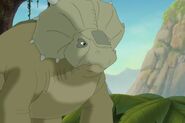Pachyrhinosaurus was a large, plant-eating dinosaur that had a bony, spiked neck frill, four short legs, and a short tail. Pachyrhinosaurus was a short-frilled ceratopsian dinosaur that was 18 to 23 feet (5.5 to 7 m) long. Pachyrhinosaurus had many small horns on the middle of its frill.
Description
The largest Pachyrhinosaurus species were 26 ft long.[1] They had strong cheek teeth to help them chew tough plants.
The skull had no true horns, but a thick, flat boss on the nose and above the eyes. Two horn-like spikes stuck out from the top of the frill and extended up and the skull bore some small horns that varied between individuals and between species. In P. canadensis and P. perotorum, the bosses over the nose and eyes nearly grew together, and were separated just by a narrow groove. In P. lakustai, the two bosses were separated by a wide gap. In P. canadensis and P. lakustai, the frill bore two more small, curved, backward-pointed horns. These were not found in P. perotorum, and in fact some specimens of P. lakustai lack them too, which may mean that the presence of these horns varied by age or sex.
Various ornaments of the nasal boss have been used to tell the species of Pachyrhinosaurus apart. Both P. lakustai and P. perotorum bore a rough, comb-like extension at the tip of the boss which P. canadensis lacked. P. perotorum was unique in having a narrow dome in the middle of the back portion of the nasal boss, and P. lakustai had a pommel-like structure sticking out from the front of the boss (the boss of P. canadensis was mainly flat on top and rounded). P. perotorum bore two unique, flattened horns which pointed forward and down from the top edge of the frill, and P. lakustai bore another comb-like horn arising from the middle of the frill behind the eyes.[2]
History
Pachyrhinosaurus canadensis, was described in 1950 by Charles Mortram Sternberg. This specimen and others came from the Scabby Butte site near Lethbridge, Alberta and was one of the first dinosaur sites found in the province (in the 1880s), but its importance was not known until shortly after World War II when two skulls were collected by Charles M. Sternberg from the Scabby Butte site and another location on the Little Bow River nearby. Another Pachyrhinosaurus skull was taken out of the Scabby Butte site in 1955, and then in 1957 Wann Langston Jr and a small crew dug up pachyrhinosaur remains. The University of Calgary has plans to reopen this site some day as a field school for university-level paleontology students.
Another Pachyrhinosaurus bonebed, on the Wapiti River south of Beaverlodge in northwestern Alberta, was worked briefly by staff of the Royal Tyrrell museum in the late 1980s but is now worked for a couple weeks each summer (since 2006) by the University of Alberta. Material from this site seems referable to Pachyrhinosaurus canadensis.
In 1972, Grande Prairie, Alberta science teacher Al Lakusta found a large bonebed along Pipestone Creek in Alberta. When the area was dug up between 1986 and 1989 by staff and volunteers of the Royal Tyrrell Museum of Palaeontology, paleontologists found a large and dense range of bones—up to 100 per square meter, with a total of 3500 bones and 14 skulls. This seemed to be the site of a mass mortality, perhaps a failed attempt to cross a river during a flood. Found amongst the fossils were the skeletons of four distinct age groups ranging from young to full grown dinosaurs, indicating that the Pachyrhinosaurus cared for their young.
The adult skulls had both convex and concave bosses as well as unicorn-style horns on the parietal bone just behind their eyes. The concave boss types might be related to erosion only and not reflect male/female differences. In 2008, a detailed monograph describing the skull of the Pipestone Creek pachyrhinosaur, and penned by Philip J. Currie, Wann Langston, Jr., and Darren Tanke, classified the specimen as a second species of Pachyrhinosaurus, named P. lakustai after its discoverer.
Classification
Pachyrhinosaurus is in the family Ceratopsidae in the subfamily Centrosaurinae. Its closest relative, Achelousaurus is likely to have been well characterized by the lack of nose horn . Together they formed the tribe Pachyrhinosaurini.
Paleobiology
Modern life at high elevations in lower latitudes resembles life at low elevation in higher latitudes. There may be parallels to this phenomenon in Cretaceous ecosystems, for instance, Pachyrhinosaurus species are found in both Alaska and upland environments in southern Alberta.
In the Edmontonian, in North America's northern biome, there is a trend of reduced centrosaurine mix, with just Pachyrhinosaurus surviving. Inland faunas are distinguished by a Saurolophus-Anchiceratops association while more coastal areas were characterized by Pachyrhinosaurus and Edmontosaurus.[3]
Pachyrhinosaurus in The Land Before Time
This is the type of dinosaur that Mr. Thicknose is. He appears in the 8th LBT movie The Big Freeze, as well as some TV series episodes. This was the only Ceratopsian which do not have horns on its head.
Gallery
References
- ↑ Holtz, Thomas R. Jr. (2008) Dinosaurs: The Most Complete, Up-to-Date Encyclopedia for Dinosaur Lovers of All Ages Supplementary Information
- ↑ Fiorillo, A.R. and Tykoski, R.S.T. (in press). "A new species of the centrosaurine ceratopsid Pachyrhinosaurus from the North Slope (Prince Creek Formation: Maastrichtian) of Alaska." Acta Palaeontologica Polonica, available online 26 Aug 2011. doi:10.4202/app.2011.0033
- ↑ Lehman, T. M., 2001, Late Cretaceous dinosaur provinciality: In: Mesozoic Vertebrate Life, edited by Tanke, D. H., and Carpenter, K., Indiana University Press, pp. 310-328.
External links
- Pachyrhinosaurus at DinoData
- Pachyrhinosaurus, from the Dinosaur Encyclopaedia at Dino Russ' Lair

